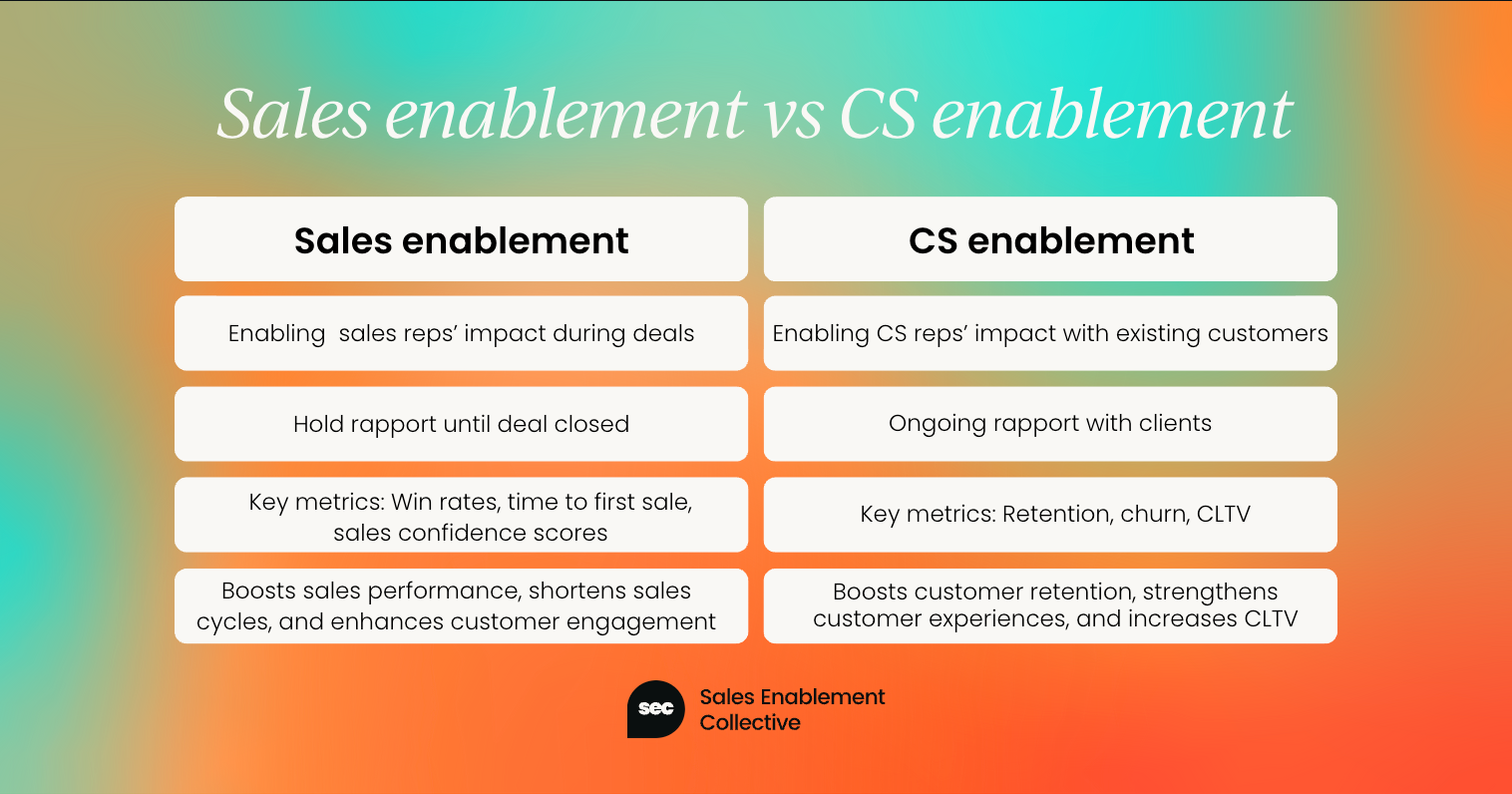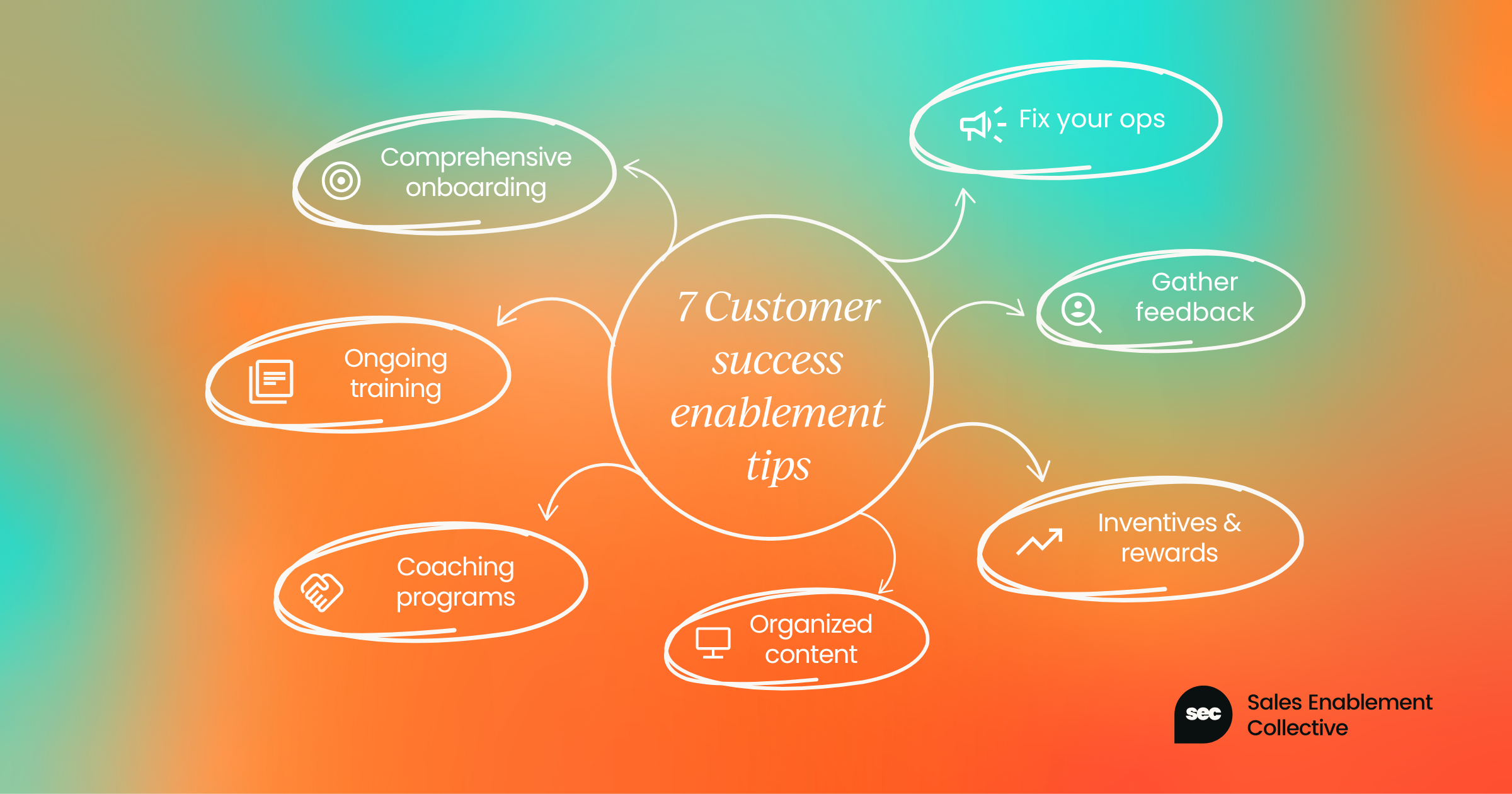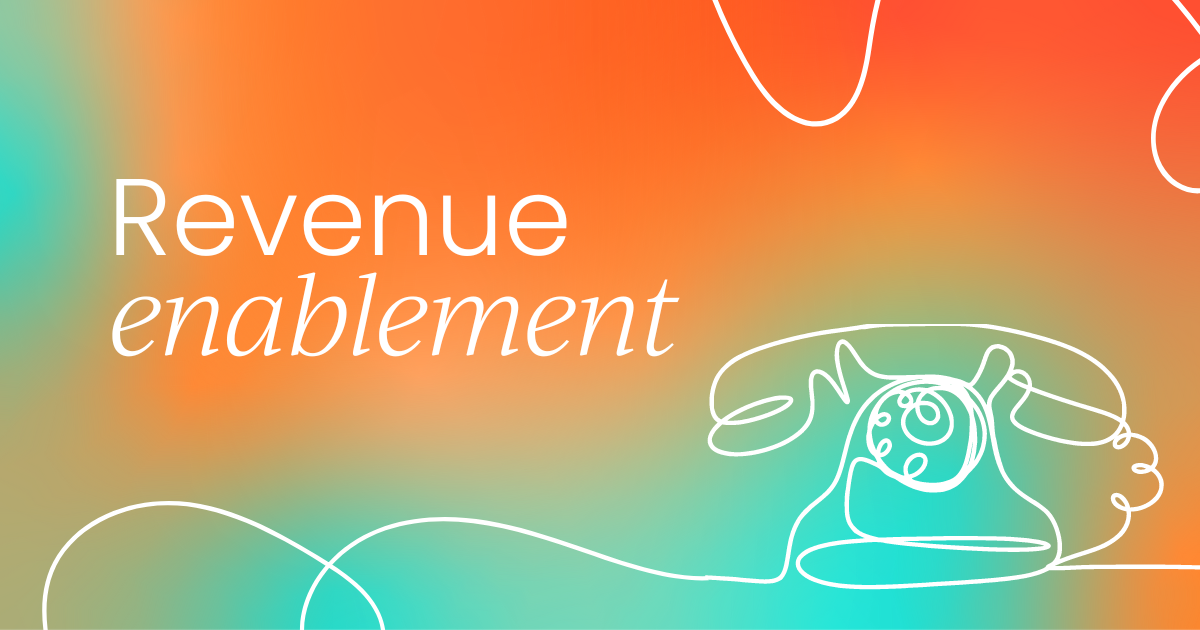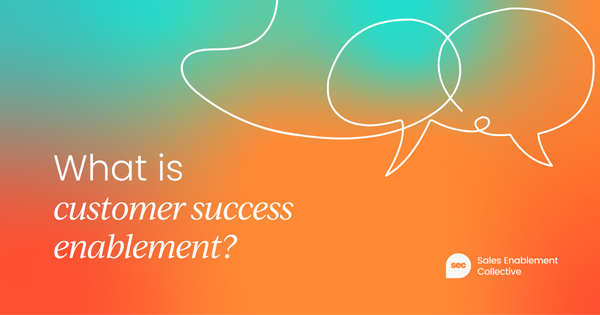With enablement functions expanding in their diversity and their remit, and with enablement roles and responsibilities becoming more diverse, some percentage of our readership will, no doubt, be looking for resources on enabling customer success teams.
While many of our existing materials on sales enablement will offer applicable advice, those responsible for customer success enablement will want specific, targeted materials to help them get the job done.
You’ve come to the right place.
What is customer success enablement?
Customer success enablement is a business function responsible for giving customer success teams the tools, ongoing training, and materials necessary to excel in giving customers the best possible ongoing experience.
Depending on the size of your business, this could include supporting teams that manage client accounts in a proactive, outbound fashion. Or, it could involve help desk-based support teams who react to inbound customer issues.

Customer success enablement responsibilities
Key customer success (CS) enablement responsibilities include:
- Onboarding new CS reps
- Defining product messaging
- Creating and curating a knowledge base of enablement content*
- Creating training materials and holding training sessions
- Collaborating with internal SMEs to produce these trainings and materials
- Gathering and implementing feedback (from both reps and customers)
In some instances, customer success enablers will also own some part of the operations function. When it comes to CS operations, this means defining the tech stack and processes CS reps will use. They may even be responsible for winning additional budget for the CS tech stack, and managing vendor relationships.
• Personas
• Products
• Success plays
• Customer/account information
How is customer success enablement different from sales enablement?
While sales enablement and customer success enablement may sound similar, they are not the same thing.
Similar tactics and approaches can work. Revenue enablement and GTM enablement functions can use different versions of the same processes and materials to enable both teams.
But it’s important to note the differences.
First, customer success and sales are different teams with different requirements. As such, your goals and strategies will differ, depending on which you’re enabling.
CS enablement is all about achieving top-tier performance in the stages after you’ve won the customer. Customer success teams are interested in retention, and growing account quality.
They’re interested in metrics like:
- Retention
- Churn
- Customer lifetime value (CLTV)
Sales teams, by contrast, are interested in acquisition and growing account quantity.

As such, you’ll look to boost important metrics like:
- Deal win rates
- Time to first sale
- Time spent selling
- Sales confidence scores
Your own enablement strategy must align with these important metrics, and help the team improve them.
Another important difference lies in the types of relationships that customer success and sales reps deal with.
Sales reps are typically only involved until the deal is closed.
CS reps are responsible for ongoing relationships that require more nurturing in the beginning, and ongoing effort to maintain.
Your enablement work will reflect this, enabling CS reps to deepen their relationships and rapport with clients, even as they improve product knowledge and expertise.
Why is customer success enablement important?
If you’ve ever struggled to prove your enablement function’s value to stakeholders, or have wanted more opportunities to progress in your career but have struggled to find them, customer success enablement could be your answer.
Enabling other teams is a quick win
The truth is, customer success teams benefit from having access to the enablement materials, trainings, and processes you’ve already built for your sales team.
In many cases, your existing enablement material needs only minimal tweaking to become useful to other teams.
This is because, when one of your sales reps closes a deal, they pass that client straight to a customer success rep.
The customer may have questions about the platform, or about how to get the most value out of your products as quickly as possible.
To win the customer, the sales rep must understand your product and how it’s differentiated. They need to make sure their messaging aligns with the language your marketing and product teams are using.
To maximize the customer’s experience with your product, your customer success rep must understand the same things.
The same educational and informational materials you’ve created for sales can then help relay the same critical knowledge to your CS reps.
5 Reasons CS enablement helps drive revenue growth
Here are five other reasons enabling your customer success team is such a win for your business, and for you as an enabler:
- Better customer retention, lower churn
More effective CS means happier customers, better retention, and lower customer churn
- Stronger reputation and brand authority
More effective CS means a stronger reputation via reviews, testimonials, and word-of-mouth praise. Brand advocates strengthen your brand authority and help you grow your customer base over time.
- Higher staff retention
Give staff an opportunity to clearly impact revenue, and the “why” behind the work becomes clear. Staff that feel supported, and feel they have the tools and knowledge they need to do their job well, are more likely to stick around.
- Data-driven decision-making
With modern tools, especially AI-powered ones, you can perform fast sentiment analysis on the language customers use in interactions with your business to keep tabs on customer satisfaction. You can also feed recurring issues back to your product and ops teams to ensure the customer experience is positive throughout purchase and onboarding.
- Competitive differentiation
I once worked for a VoIP (voice over IP) provider in the U.K. Their main competitive differentiator? Their customer success team.
In the business telephony industry in the U.K., poor customer service is pretty much the norm. My old employer looked to take advantage of a gap in the market and soak up the disillusioned customers who were leaving legacy contracts with older, slower telecoms companies.
It worked.
Eventually, they branched out and began differentiating with their product, too. But in the beginning, amazing customer service experiences built that business and won it its first round of investment.
Though there was no formal enablement function in that business, the customer success manager worked tirelessly to enable his team, at great benefit to the business.
7 Customer success enablement best practices
1) Build a comprehensive onboarding program
Good enablement starts at the beginning, the moment reps join the business.
This is your first shot at making a strong, positive impression. Get the onboarding process right, and you may just create a champion for your enablement efforts. Someone who’ll vouch for the quality and utility of the content and training you produce.
But onboarding is also one of an enabler’s core responsibilities. Own it well, and you get to decide all the important things your CS reps should know, and the order they should learn them in.
This gives you incredible control over the effectiveness of your reps (and the speed at which they become effective.)
2) Hold ongoing training sessions
Nothing stays the same for long.
Products change, new competitors come onto the scene…
You’re already enabling your sales reps to speak authoritatively about new products and features, and to handle competitors effectively.
Your CS reps need all the same info when dealing with existing customers.
That’s why you need to make sure you hold ongoing training sessions for your reps.
Use them to bring the team up to speed on developments both internal and external to the business. This makes sure your reps remain effective, never failing to come across as strong authorities on the state of the industry, and the value you bring to it.
3) Create coaching programs
Most enablement teams are small, so you need to enlist help.
Customer success managers are perfect targets. Enable them, and you help them to help their reps, scaling your influence.
Coaching programs are your means of doing this. Managers must coach reps on best practices in an ongoing manner.
To do this, they must understand everything their reps need to understand.
More than that, though, they need to be able to see where their reps are going wrong, and correct their errors constructively.
To some, this might come naturally. But others will find it hard to change their reps’ behavior.
For this reason, a solid coaching program, where you train managers to build their coaching skills, pays dividends.
4) Organize your enablement content
If you make your content difficult to find, reps won’t use it.
So when they need to brush up their knowledge on a feature that rolled out a few months ago, or on how you differ from your core competitors (and who they are)... they simply won’t.
This isn’t good. You want your reps to be able to find the content they need, when they need it.
Organize your enablement content (through tagging, for example) in a centralized repository, or content hub.
Chances are, this’ll be a content management system, or CMS. Most enablement platforms include one as standard, but you can also purchase a CMS as a standalone tool.

5) Fix your ops
If you have a dedicated operations team… excellent! You can delegate this task to them.
But whether you own enablement operations or not, you’ll want to make sure that the processes, and the tech stack you use, support your efforts.
If the tools in your tech stack:
- Have low adoption
- Are riddled with inefficiencies
- Are bloated with features no one uses…
…you can free up wasted budget by unsubscribing to the tools with the lowest ROI.
Better still, you’ll find opportunities to fix inefficiencies and make sure the processes your customer success team relies on to operate are in ship shape.
6) Incentives, rewards, and pay management
Compensation is something else that’d typically lie with your ops team, but can play the part of enablement.
Motivation can be a blocker for reps on any team. Use incentives to push content adoption rates, and training completion rates, higher if you have to.
Speak to the necessary stakeholders to make these things happen. Doing what’s necessary to ensure incentives align with business goals is a smart strategic decision for any leader. As the enablement pro, you’re capable of effecting these changes.
7) Continually gather and implement feedback
You can’t fix an issue if you don’t know it exists.
Make sure you’re speaking to reps regularly, and gathering feedback on what’s working well, and what isn’t.
This will keep you aligned with the biggest pain points your CS team is facing. When you know about them, you’ll be able to effect changes that eradicate those problems.
This is also where metrics come into play. Make sure you have your eye on a set of key metrics, so you can judge the effectiveness of your efforts over time in ways both qualitative and quantitative.
Finally, consider incorporating customer feedback into your enablement efforts, as well.
4 Challenges to expect when enabling customer success
1) Keeping materials current
As an enabler, you’ll be producing a lot of content.
But things change fast, so keeping all your enablement collateral up-to-date can quickly become a full-time job.
Since your responsibilities go further than refreshing the material in your CMS, you’ll need to effectively prioritize the task of refreshing content alongside your other duties.
2) Content and tool adoption
Like it or not, some of your CS reps think they’ve got it all figured out.
They don’t need your help, and they want to keep doing things the way they’ve always done them, thank you very much.
Sure, this won’t be true for your whole CS team, but some people will resist the changes you propose. You should expect this.
It’s tricky, but the answer is to watch how your reps use the processes and platforms you have at your disposal. You must stamp out any inefficiencies in these processes. Find the annoyances that push your reps away from using the tools and materials you give them.
Make using these tools and materials the path of least resistance for your reps. Make it easier (and more effective) than literally every other option available to them, and you’ll find adoption rates increase accordingly.
3) Time management
Enablement is all about helping your reps to do their jobs well.
You can only do this if you understand their pains and frustrations.
To do that, you need to regularly gather their feedback, figure out what needs to change, and then make those changes.
But all of this takes time. Especially, if you’re taking pains to collect data that’s accurate. To collect honest responses, you either need to build masses of rapport with reps individually, or you need to collect data anonymously with well-crafted surveys.
And when the problems reps are facing are foundational, effecting necessary changes can take months.
These things make it harder for you to achieve quick, strong impact with your enablement program.
4) Tech stack issues
Your tech stack is the infrastructure that holds your teams together.
The right tools streamline the data collection process and automate much of the organizational work, so you and the CS team can focus on strategy.
Software will include tools like:
- Customer relationship management (CRM)
- Communication and messaging platforms
- Data analysis tools and software
The CS team will use much of this software multiple times a week, and some particularly important pieces of software all day, every day.
If there are issues, it becomes difficult (or impossible) for reps to do their jobs.
Issues can be as (seemingly) small and fixable as low adoption – reps opting not to use the software you’ve invested in to make their lives easier. Or, they can be as critical as reps being unable to interact with customers and clients, in the case of your customer support tools or business phone system software.
Customer success enablement metrics
Even when implementing all of the above best practices, and dealing with the above challenges, you need to be able to measure whether what you’re doing is working.
The metrics and KPIs you’ll use to measure success in customer success enablement are similar to those you’ll use for measuring success in sales enablement, too.
Here’s a list to get you started:
- Agent performance metrics
- Feedback scores
- Average resolution time
- Customer satisfaction scores
- CSM time to value (ramp time)
- First contact resolution
- Time savings
- Training completion rates
- Training satisfaction / NPS scores
- Assessments and examination scores
- Tool and content adoption rates
Find more information on enablement metrics and KPIs
Still looking for next steps?
Don't worry, our eBook isn't going anywhere.
But a few clicks are all that separate you from discovering:
- Exactly what sales enablement is (and what it’s not), so you can start doing it the right way. ✅
- The five core pillars of sales enablement (plus a special bonus pillar that’ll help you to work faster and more efficiently). 🔑
- A simple-to-understand mental model of the sales enablement function, giving you clarity and confidence as you navigate enablement challenges. 💡
Discover the pillars now. 👇



Sales enablement insider
Thank you for subscribing
Level up your sales enablement career & network with sales enablement experts
An email has been successfully sent to confirm your subscription.
 Follow us on LinkedIn
Follow us on LinkedIn


.png)






